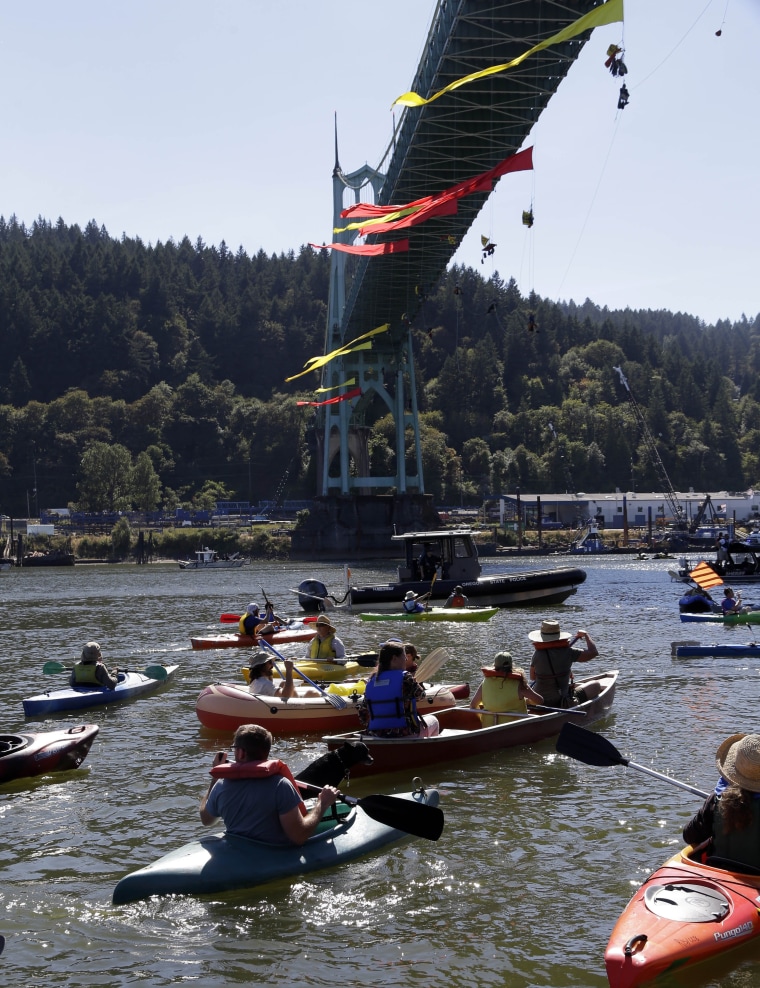Greenpeace protesters dangling from a Portland, Oregon, bridge lowered themselves to the Willamette River on Thursday, clearing the way for an oil company icebreaker to continue on its way to the Pacific Ocean and then the Alaskan coast.
The 13 protesters had been hanging from the St. Johns Bridge for almost 40 hours in an attempt to block Royal Dutch Shell's icebreaker MSV Fennica — which stopped in Portland for repairs Saturday — from returning to sea.

After almost two days into the protest, members of the Portland Fire Bureau's technical rescue rope team built their own rope system Thursday crossing the bridge, Lt. Rich Tyler said Thursday night.
Then, "we ended up lowering ourselves down to where the protesters were," he said.
The first two protesters the officers reached agreed to lower themselves to a Multnomah County sheriff's rescue boat in the river below.
The next ones, however, refused, "so we went down to where the ropes were connected and anchored, attached our ropes to their ropes ... and lowered them down" without their cooperation, Tyler said.
Once the first three protesters had been removed and the Fennica had enough room to pass — it sailed through right under them — "the rest came down voluntarily," he said.
Meanwhile, "kayaktivists" in the river tried to block the icebreaker's path, but crews hooked their kayaks to jet skis and pulled them out of the way. The ship cleared the bridge about 6 p.m. (9 p.m. ET).
The ship's next confrontation could come in Astoria, Oregon, where it was expected to arrive after 11 p.m. (2 a.m. Friday ET). The Coast Guard said it was prepared to enforce a 500-yard safety zone around the Fennica as it made its way through the Willamette and Columbia rivers Thursday night and Friday.
The protest was a costly one for Greenpeace, which was fined $2,500 for every hour the ship was stalled — eventually reaching $17,500 — after a U.S. district judge in Alaska found the organization in civil contempt.
Related: Activists Hang From Oregon's St. Johns Bridge to Protest Shell's Arctic Oil Drilling
And police carted off an undetermined number of protesters and other people in plastic handcuffs, with charges to be determined, probably Friday, police said.
But Mary Nicol, senior Arctic campaigner for Greenpeace USA, said it was worth it.
"We found that the blockade was successful," Nicol told NBC station KGW of Portland. "Climate change does present a real threat to everyone globally."
Royal Dutch Shell, which the U.S. Interior Department granted the final two permits it needs to explore for oil in the Arctic, said in a statement Thursday night that with the Fennica on its way to Alaska, "the Transocean Polar Pioneer commenced initial drilling operations" immediately in the Chukchi Sea.
Portland Mayor Charlie Hales said the protest made for a "hard day," because he opposes drilling in the Arctic but had law-enforcement responsibilities as mayor to carry out.
"It's time to move from protest to action, to changing the laws," Hales said Thursday night. "After all, that's the point of the protest."
